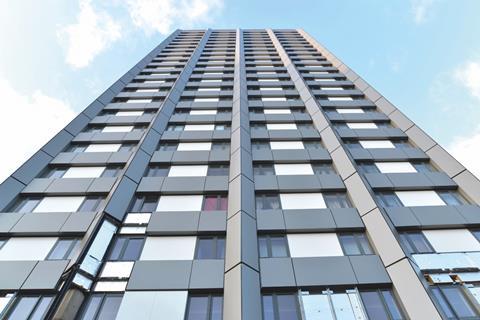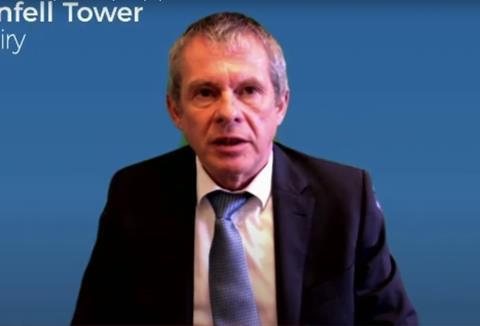Arconic, Celotex and Kingspan defend their involvement in 2017 disaster after final report brands them “dishonest”
The three firms which manufactured the products installed on Grenfell tower have come out fighting following a series of damning criticisms levelled against them in this morning’s report into the causes of the fire at the building.
Arconic, Celotex and Kingspan have all released statements defending their roles in the blaze which killed 72 people in 2017 after the final report into the disaster repeatedly described them as “dishonest”.

Around 3,000 sq m of Arconic’s ACM cladding panels were installed on the 24-storey west London tower during its 2015-16 refurbishment and have been found by the inquiry to be the “primary cause” of the subsequent fire.
> Also read: Product manufacturers knowingly misled the market over combustible construction materials, Grenfell Inquiry concludes
The cladding system also included insulation manufactured by Celotex and a smaller amount of insulation made by Kingspan.
All three products were combustible and were being marketed using misleading test results, the inquiry has found in its 1,600-page report, published this morning in seven volumes.
But Arconic’s France-based subsidiary Arconic Architectural Products SAS (AAP), which supplied the Reynobond PE 55 panels, said the material was “safe to use as a building material” and rejected any claim that it “sold an unsafe product”.
It added that it “regularly conducted tests of its materials using third-party testing bodies” and insisted these reports were all publicly available and made available to customers.
“AAP did not conceal information from or mislead any certification body, customer, or the public,” the firm said in a statement this morning.
The firm’s comments appear to be directly contradicted in the findings of the inquiry team, which analysed historic test data for the panels and interviewed senior representatives from AAP including its president Claude Schmidt.

The inquiry has previously heard the firm had been selling the ACM panels for at least ten years using the test report of a less combustible version of the product.
When a fire test on the version of the product used on Grenfell tower, which came in a folded ‘cassette’ form, it had failed “disastrously”. This result was never passed on to the British Board of Agrément (BBA), a certification body, which then issued certificates allowing the product to be used on high rise buildings.
This morning’s report said Schmidt had accepted the cassette panels “never achieved” a Class B classification, the fire standard required for use on tall buildings, and the firm knew from early 2005 that the only test evidence of the product showed it had the “potential to react to fire in an extremely dangerous way”.
Despite this, Arconic had “persisted in telling the market” that the product had achieved Class B based on the test results of the other, less combustible version of the panels.
It did this partly because it believed the test on the cassette had achieved a “rogue” result, according to the inquiry report. But further tests carried out in the years leading up to the Grenfell fire had similarly failed.
“Even if, contrary to our conclusion, Arconic had believed in early 2005 that the result of Test 5B was unrepresentative, by 2011 it knew very well that it was not,” the report said.
But the firm still did not disclose the results to any testing organisation, certification body or end user in the UK at any time before the Grenfell Tower fire, the inquiry found. Schmidt told a hearing of that if the fire had not taken place it was “likely that they would have remained secret.”
Asked for further clarification of their statement, Arconic said it “stands by its statement in light of the report’s findings” and will “not be adding to the statement at this point.”
Celotex, which was found to have rigged the fire test of the RS500 insulation product used on Grenfell Tower’s refurbishment, said it had conducted a “significant and thorough” internal review of how the product was tested, launched and marketed following the fire.
It added that it has since “reviewed and improved process controls, quality management and the approach to marketing within the Celotex business to meet industry best practice”.
But the firm claimed that fire tests commissioned following the review had indicated that the cladding system described in marketing literature “met the relevant safety criteria”, and was “substantially different” to the system used on Grenfell tower.
“Decisions about design, construction and the selection of materials for the Tower were made by construction industry professionals,” the firm added.
Kingspan, which manufactured around 5% of the insulation used in the tower’s cladding system, said it acknowledged the “wholly unacceptable” failings that occurred in its UK insulation division in the years before the disaster but these were “not causative of the tragedy”.
The firm was found to have been marketing its popular K15 insulation, the product used on Grenfell, with a test report of an earlier and chemically different version of the product.
When the version on the market was tested it turned the rig into a “raging inferno” which had to be extinguished over fears that it would set fire to the laboratory.
“Kingspan has already emphatically addressed these issues, including the implementation of extensive and externally-verified measures to ensure our conduct and compliance standards are world leading,” the firm said.
Product manufacturers’ responses in full
Arconic:
Arconic’s subsidiary, Arconic Architectural Products SAS (AAP), supplied sheets of aluminium composite material that were used to manufacture the rainscreen for the Grenfell Tower refurbishment.
The fire was a terrible tragedy and as Arconic remembers the 72 people who died, our thoughts remain with the families, friends and all of those affected.
AAP was a core participant in the Inquiry and has acknowledged its role as one of the material suppliers involved in the refurbishment of Grenfell Tower.
The company respects the Inquiry process. AAP cooperated fully with the work of the Inquiry and will continue to engage with further legal processes. Together with other parties, AAP has made financial contributions to settlements for those affected, as well as to the restorative justice fund.
Throughout the Inquiry, AAP has maintained a number of points:
- AAP sold sheets of aluminium composite material as specified in the design process. This product was safe to use as a building material, and legal to sell in the UK as well as the more than thirty other countries in which AAP customers purchased the product. We reject any claim that AAP sold an unsafe product.
- AAP regularly conducted tests of its materials using third-party testing bodies. Reports on these results were all publicly available, and AAP made these reports available to its customers.
- AAP did not conceal information from or mislead any certification body, customer, or the public.
Celotex:
The publication of the Grenfell Tower Inquiry Report marks the conclusion of the Inquiry’s work and we are considering its contents with care.
Our business’ response to what happened started immediately after the fire in June 2017. We conducted our own review to interrogate the circumstances in which the RS5000 product had been tested, launched and marketed. This review was a significant and thorough undertaking, and the results of that work were disclosed promptly and proactively to relevant stakeholders, including the Grenfell Tower Inquiry.
Independent testing commissioned following the review demonstrated that the cladding system described in the Celotex RS5000 marketing literature met the relevant safety criteria. That system was substantially different to that used at Grenfell Tower. Decisions about design, construction and the selection of materials for the Tower were made by construction industry professionals.
Since the fire, we reviewed and improved process controls, quality management and the approach to marketing within the Celotex business to meet industry best practice. Celotex Limited continues to cooperate fully with all official investigations into the Grenfell Tower fire.
We reiterate our sympathies to everyone affected by the fire.
Kingspan:
Today is another extremely difficult day for the relatives and survivors of the Grenfell Tower fire and we extend our deepest sympathies to those impacted by the tragedy.
We welcome the publication of today’s report which is crucial to a public understanding of what went wrong and why. It explains clearly and unambiguously that the type of insulation (whether combustible or non-combustible) was immaterial, and that the principal reason for the fire spread was the PE ACM cladding, which was not made by Kingspan.
Kingspan has long acknowledged the wholly unacceptable historical failings that occurred in part of our UK insulation business. These were in no way reflective of how we conduct ourselves as a Group, then or now. While deeply regrettable, they were not found to be causative of the tragedy.
Kingspan has already emphatically addressed these issues, including the implementation of extensive and externally-verified measures to ensure our conduct and compliance standards are world leading.
We remain committed to playing a leading role in providing safe and sustainable building solutions, including continuing to work with government and industry partners.
















No comments yet